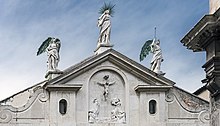|
Ateneo Veneto
 The Ateneo Veneto di Scienze, Lettere ed Arti is an institution for the promulgation of science, literature, art and culture in all forms, in the exclusive interest of promoting social solidarity, located in Venice, northern Italy. The Ateneo Veneto is made up of 300 members resident in the city and in the province of Venice, elected by the Assembly, which is also responsible for appointing the chairman and the academic council. Honorary, Non-Resident and Foreign Members, elected by the Assembly also participate in the life of the Ateneo. The Ateneo Veneto was formed on 12 January 1812 through the merger of the Società Veneta di Medicina, the Accademia dei Filareti, and the Accademia Veneta Letteraria pursuant to a decree of Napoleon I dated 25 December 1810.[1] The first chairman was Leopoldo Cicognara. It was the Ateneo Veneto that saw the first stirrings of Venetian liberalism, with speeches by Daniele Manin, who was president of the short-lived Republic of San Marco from 1848 to 1849, and by Niccolò Tommaseo. Throughout the 19th and 20th centuries the Ateneo Veneto acted as a forum for debates on crucial matters for the city in the fields of culture, science, art, literature, medicine, politics, economics and law. Such free discussions on major issues have continued to characterize the Ateneo Veneto, testifying to its civic, social and cultural commitment.  HistoryOriginally the building hosted a confraternity, the Scuola Grande[dubious – discuss] di San Fantin, also known as the Scuola di San Girolamo or Scuola di Santa Maria e di San Girolamo (devoted to justice), as stated in the official documents of the Venetian Republic, more commonly referred to as "di San Fantin" or "dei picai" ("of the hanged men"). During the sixteenth century a number of great architects, painters and sculptors of the Baroque and Mannerist schools embarked upon a major reconstruction of the Scuola; by the beginning of the seventeenth century the building was more or less as one sees it now. The church on the ground-floor is now the conference-hall. The albergo, on the first floor, is a reading-room: around 1664 the albergo piccolo was added (now the "Sala Tommaseo"), as was the new sacristy on the ground floor (now a meeting-room). On the top floor is the library which contains around 40,000 volumes, some of them of inestimable historic and artistic value. The art-collection, with works by Tintoretto, Veronese, Palma il Giovane, Antonio Zanchi, Francesco Fontebasso, Pietro Longhi and Alessandro Vittoria, is also extremely valuable. The Ateneo Veneto, a non-profit organization, institution of science, literature and arts, is committed to making full use of its historical and artistic heritage (the building, art-collection and library) and to the pursuit of cultural activities (scholarly studies, courses in history, science, literature and art, lectures, conferences, theatrical, musical and cinematic events, exhibitions and the Torta Prize for restoration) and social initiatives (hosting local associations and committees without their own premises, collaborating with the institutions of the city, co-organizing University courses for senior citizens held at the Ateneo Veneto, contributing to the cultural education of young students and scholars through subsidized training-courses in the library and the Ateneo Veneto, and co-operating with the city's cultural organizations). It will continue to expand its services, including recreational activities connected with the above-mentioned initiatives, using the Internet and multi-media facilities. Presidents
References
External links |
Portal di Ensiklopedia Dunia